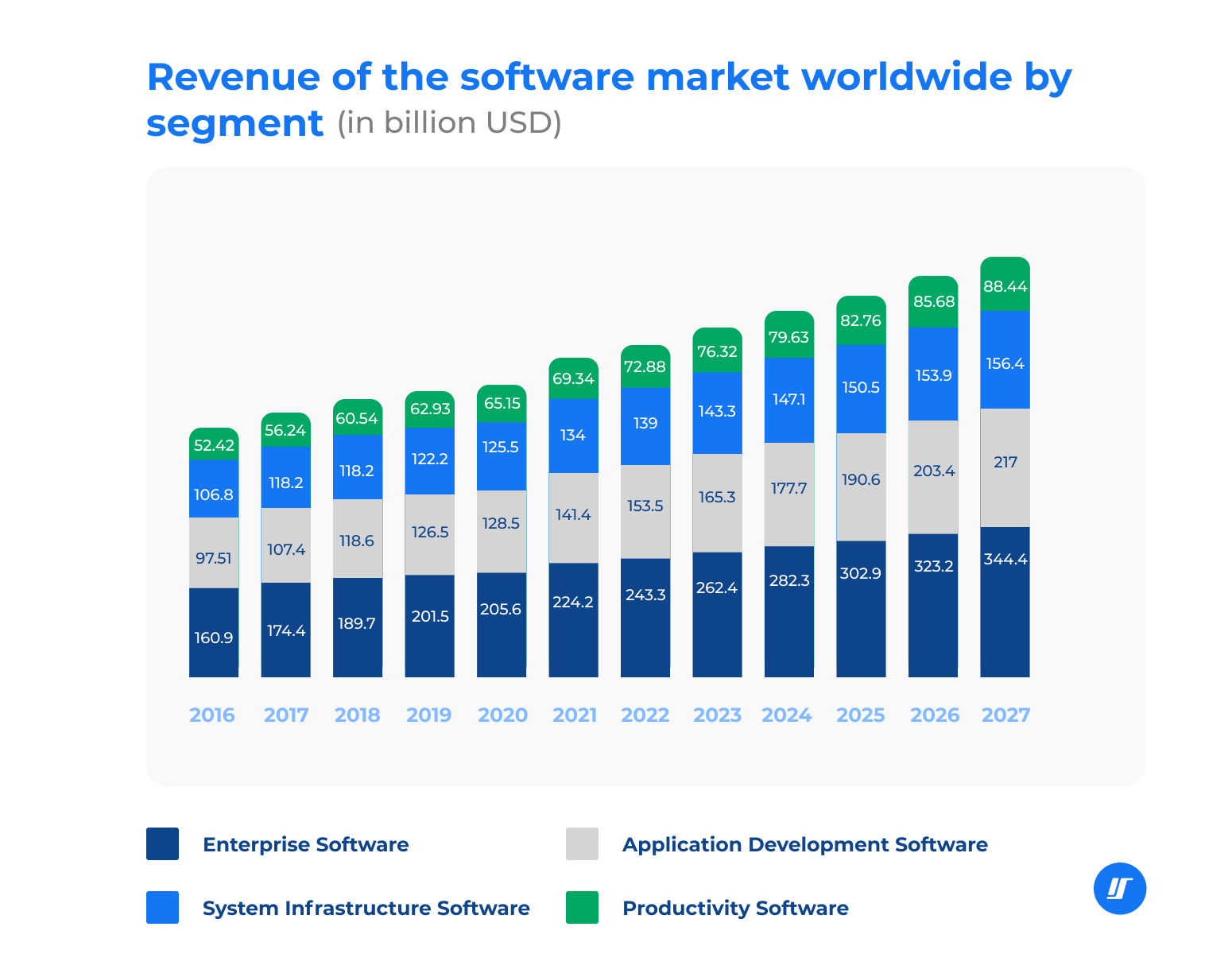We live in a world shaped by software developers. Every day, billions of people around the world use apps, games, websites, and other software products without really thinking about the teams that created them. But business owners can’t afford to overlook software development trends.
Enterprise software plays a big part in finding success in a digital world. If your business is looking for software solutions to make operations smoother, you will need to keep abreast of emerging technologies in software development—and assemble a great development team.
Why Your Business Needs a Software Development Team?
Software developers and engineers have an inside joke: “Building software is like building cathedrals; first you build it, then you pray!” However, getting together a software development team with the right technical know-how can remove the uncertainties of the process. This makes it crucial to work with seasoned professionals with experience in products that are in line with the latest software development trends.
Software development is what transforms ideas into tangible digital products. It’s a process that includes ideation, creation, design, and launch of software, along with providing ongoing technical support for the software’s users. Naturally, such technical responsibilities need to be fulfilled by IT experts, which is why businesses need to assemble a qualified team that is up to date with software industry trends.
Across the world, software development trends indicate that companies spend more than $1 trillion on enterprise software every year. These software solutions help companies become more efficient by reducing costs and streamlining business processes.


Whether it’s a customer-facing product or a tool for internal use, you should contact experts to help design software solutions. According to TechReport, 84.7% of software companies specialize in enterprise application development, so you will have plenty of options when looking to recruit your software development team.
What are the Major Factors That Influence the Software Development Team Structure?
Every software development project is unique. That’s why you should tailor the structure of your software development team according to each project’s stated goals and objectives and the trending technologies in software development. When assembling your software development team, there are four main factors you should consider.
Let’s take a closer look at each one of these.
Project Type and its Complexity
It’s counterproductive to assemble a software development team before the nature of the project is made clear.
Before finding team members, ask yourself what kind of software product you want. If you are experimenting with a new idea and only want software as a proof-of-concept, a smaller team of five or fewer members will be more than enough. However, if your product is much more complex, like a market-ready e-commerce app with third-party integrations, you will need a much larger team.
As the scope of a software development team increases, so does the required team size. Software developers come in many stripes, from generalists to specialists, with hybrid developers in between. A niche software product with very specific functions will require specialists on the team, whereas a more generic product can be created by generalist and hybrid developers.
Development Budget
Good software costs money. It’s a simple fact, and the sooner you accept it, the easier it will be for you to get the most out of your software development budget. With the funds available, you can either hire full-time developers directly or contract the services of third-party software developers. It’s up to you to decide which is more cost-effective for your company.
Once a software development project has an allocated budget, you need to find ways to maximize its usefulness. Consider focusing on high-priority features first or limiting the size of your team. When you try to pack in too many features or hire a large team without planning out each member’s roles, your expenses will go up.
It is, therefore, advisable to ensure that the project’s budget, scope, and team composition are all aligned perfectly before starting the software development process.
Time to Develop a Project
Rome wasn’t built in a day, and neither is good software. Rushing a software development project is a surefire way to end up with a buggy product that doesn’t perform how it should. Looming deadlines are a reality that every software development team deals with on a regular basis, but effective time management makes the process of delivering the product much less stressful.
You should carefully consider the timeline of your project when assembling a team. If you have a small software development team, you should account for the project taking longer. Larger development teams might be able to complete a project in less time, but such teams will also need to be managed closely to ensure cohesion.
Sometimes, if you have a very tight deadline for an urgent project, you will have to bring senior specialists on board to help achieve quick results.
Size of the Project
In software development, project size refers to the number of features and functionalities that need to be added to the product. The more feature-rich a software product is, the bigger the project becomes. This means you must hire more team members to complete it successfully.
Every additional feature added to a software product could require a specialist developer on the team to ensure it works properly. If your team is made up entirely of generalist developers, it might be smarter to limit the size of the project.
There are two ways to account for project size during software development. In the first approach, you list out the features you want to see in the finished product and then hire a team to bring those ideas to life. On the other hand, you can assemble a team first and then work out what features will be included according to the team’s composition, specializations, and capabilities.
All of the factors mentioned above are essential when putting together a software development team. You should begin hiring software developers for a project only after its scope, size, budget, and timeline have been finalized.
Modern Software Development Team Structure
Once you have a clear understanding of all the factors that will influence your software development team’s composition, you’re almost ready to begin.
But first, you need to decide on what approach you will follow for software development. The two most common approaches are the traditional method, which is sometimes also called the waterfall method, and the second is agile development.
The approach you choose will add clarity to exactly what roles your team will need to fill. From the coders who prepare the foundational structure of the software to the testers who comb the finished product for bugs—there are many roles in a modern software development team that need to be filled with competent professionals.
Product Owner
In software development teams, product owners are a vital link between engineers, developers, and clients. They work closely with the client to understand their business needs and define the project’s overall scope. The other important responsibility product owners have is to monitor the development team’s progress.
The product owner’s job is to schedule tasks for developers, ensure timelines are being met, and also ensure that the promised deliverables are all being met. As the key point of contact for clients and stakeholders, product owners need to be well-informed about the customer’s product, market, and business needs.
Business Analyst
The business analyst’s role appears to be superficially similar to that of the product owner because they both need to work with the client and development team. However, the key difference between the two is that business analysts focus much more on the technical aspect of software development, while product owners have to focus on customer satisfaction.
A software development business analyst’s main job is to work with the client to understand their business needs and then identify areas where software development can make a positive difference for them. They also need to be aware of software technology trends to create a list of requirements to take to developers, which eventually become the list of features and functions in the finished software product.
Project Manager
Software development is a team-based activity, and every team needs a captain to energize their efforts. Whether you’re using a traditional or agile approach, that captaincy role can be filled by a project manager. Project managers are the driving force behind the software development team and oversee the entire development process.
The project manager is responsible for assigning tasks to team members based on their strengths, enabling communication between them and other key stakeholders. It’s also their job to ensure that a project proceeds as planned, according to budget, and on schedule with all the promised deliverables.
Software Architect
Designing software is complicated, with many moving parts and unforeseen complications. Every team needs a software architect to navigate the complexities of software development. This will usually be the most senior software engineer on the team, and they will oversee the rest of the development team’s work and make executive decisions regarding software design.
The software architect is the person who selects which tools and platforms the team will use to complete the project. One of their key responsibilities while overseeing the software’s architecture and components is ensuring the product is secure, meets all of the client’s technical and functional requirements, and is relevant to the current trends in software development.
Software Developer
The main body of your team will be made up of software developers. These are the team members whose output helps create the software product from the ground up. Whether you are building an entirely new software solution or making changes to an existing one, you will need to hire experienced software developers to do the job.
Every team will have a mix of developers. There are front-end developers who work on the user-facing portions of a product. There are also back-end developers who work on the inner workings of an application by writing code and devising algorithms. Then, you have full-stack developers who can work in any capacity for software development.
Whatever the type, a successful software developer needs to be technically proficient and well-versed in a variety of computer programming languages.
Software Testing Engineer
It’s essential that your software development team includes testers if you want to create a product that users value. Software testing engineers act as your quality assurance (QA) team during development. In traditional development approaches, the testing engineers conduct tests toward the end of the software development life cycle (SDLC).
However, when following the agile approach, testing is conducted alongside other development approaches in short sprints.
As QA testers, these engineers have to ensure the software performs according to the client’s requirements. They identify both functional and non-functional defects in the software, reporting on their findings to the developers and helping refine the product over multiple iterations.
UI/UX Designer
The UI/UX designer is a vital member of every software development team because they are responsible for curating the user experience. While front-end developers focus on the functional aspects of user-facing features, the UI/UX designer has control over how users will interact with those features.
A UI/UX designer creates every software’s visual interface. While developers have to ensure the product is functional, UI/UX designers are more interested in making the product appealing and engaging for end users. They need to have an eye for design, attention to detail, and be well-versed in using design tools.
DevOps Engineer
No software development team is complete without DevOps specialists. The DevOps engineer ensures collaboration between the developmental and operational arms of the team. They need to be well-versed in both the technical requirements of software development and the business needs of the client.
DevOps engineers are the ones responsible for the ongoing maintenance of a software product, even after the end of a development cycle. They are the ones who set up pipelines for continuous integration and continuous delivery after software has been finished. If a software product starts to display marked improvements with each successive iteration, that’s a sign that their DevOps engineer is doing a good job.
Software Development Teams vs. Development Approaches
Due to the multifaceted nature of software development, it’s worthwhile to consider different approaches to find which one works best for your needs. Projects that are smaller in scope can benefit from a sequential approach, but if there’s a chance of scope creep or the project has an extensive scope to begin with, then an agile methodology will work best.
There are several key differences between traditional (waterfall) methods and agile methods.
Let’s take a closer look.
| Traditional/Waterfall Development | Agile Development |
|
|
|
|
|
|
|
|
|
|
|
|
|
|
Now that you’re familiar with the key differences between waterfall and agile development, you can make a well-informed decision based on your approach before assembling a software development team.
How to Build a Successful Software Development Team?
Once you’ve assembled a team and chosen a development approach, all that remains is to give the team the best possible environment to accomplish their goals. Successfully leading a software development team involves careful planning, smart recruitment, and cross-functional collaboration. To create the conditions for success in software development, you should follow these best practices:
- Encourage transparent, effective, and productive communication between team members.
- Establish clear goals and expectations and make them clear to every stakeholder on the project.
- Empower team members to make decisions that support the team’s objectives.
- Hire the right mix of developers, including generalists and specialists, so that every member is comfortable with their workload and caught up with the latest trends in software development.
- Promote team cohesion, build trust between team members, and foster an attitude of shared success.
Summing Up
Software development teams perform a critical function, designing the digital tools used by consumers to connect with companies. Investing in enterprise software is a sound business decision, especially for a company that wants to enable a digital transformation in its operations. Putting together a software development team staffed by experts to fulfill each role helps create products that benefit both businesses and their customers.
It takes technical expertise to create a well-made, popular software application. If you wish to develop software for your business, you should work with a company known for excellent end-to-end software development like Intellectsoft.
From web and mobile applications to customized software solutions, Intellectsoft has over 15 years of experience in helping companies achieve their goals with software solutions. Regardless of your industry, Intellectsoft can help you develop software technology that boosts your business’ performance and delights your customers.
Subscribe to updates
Source link











